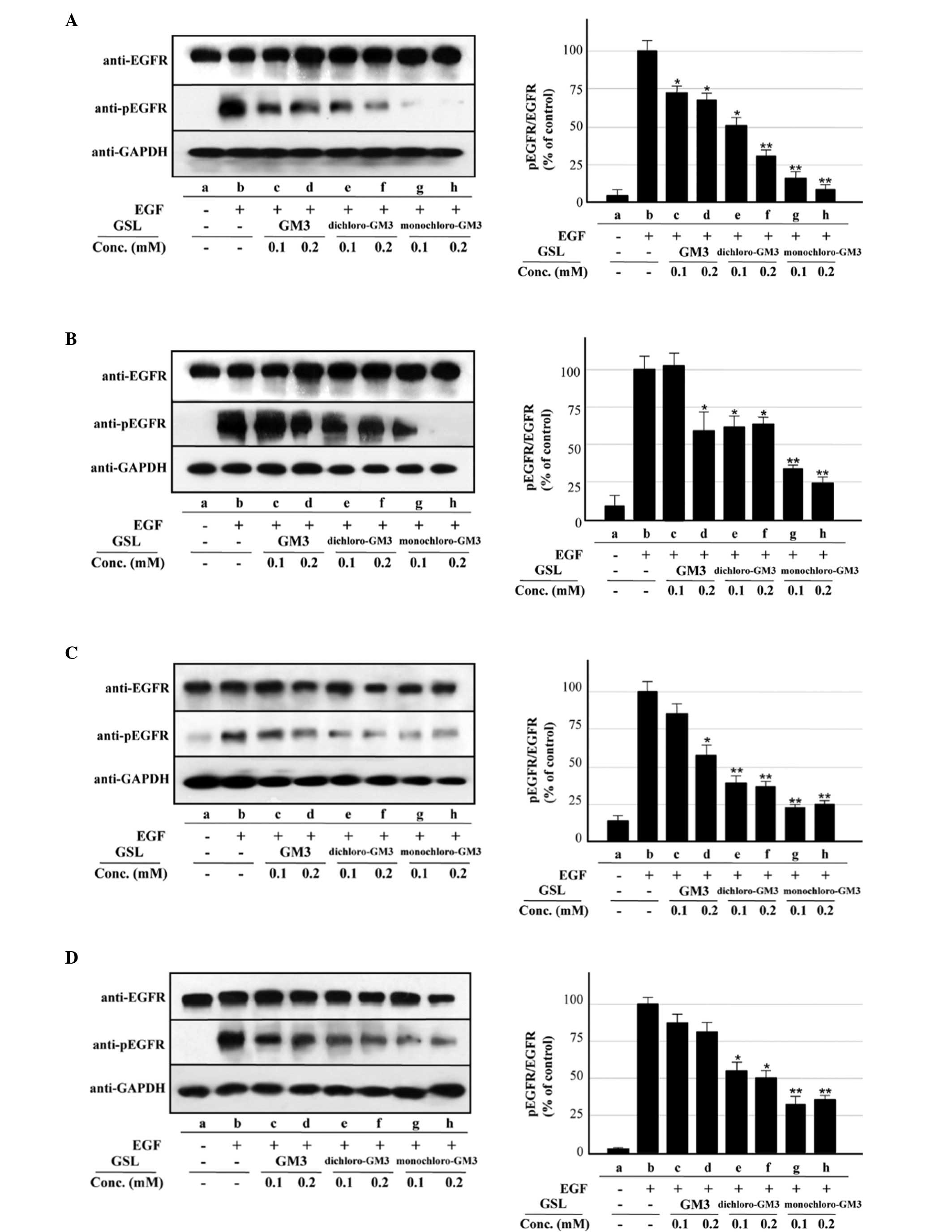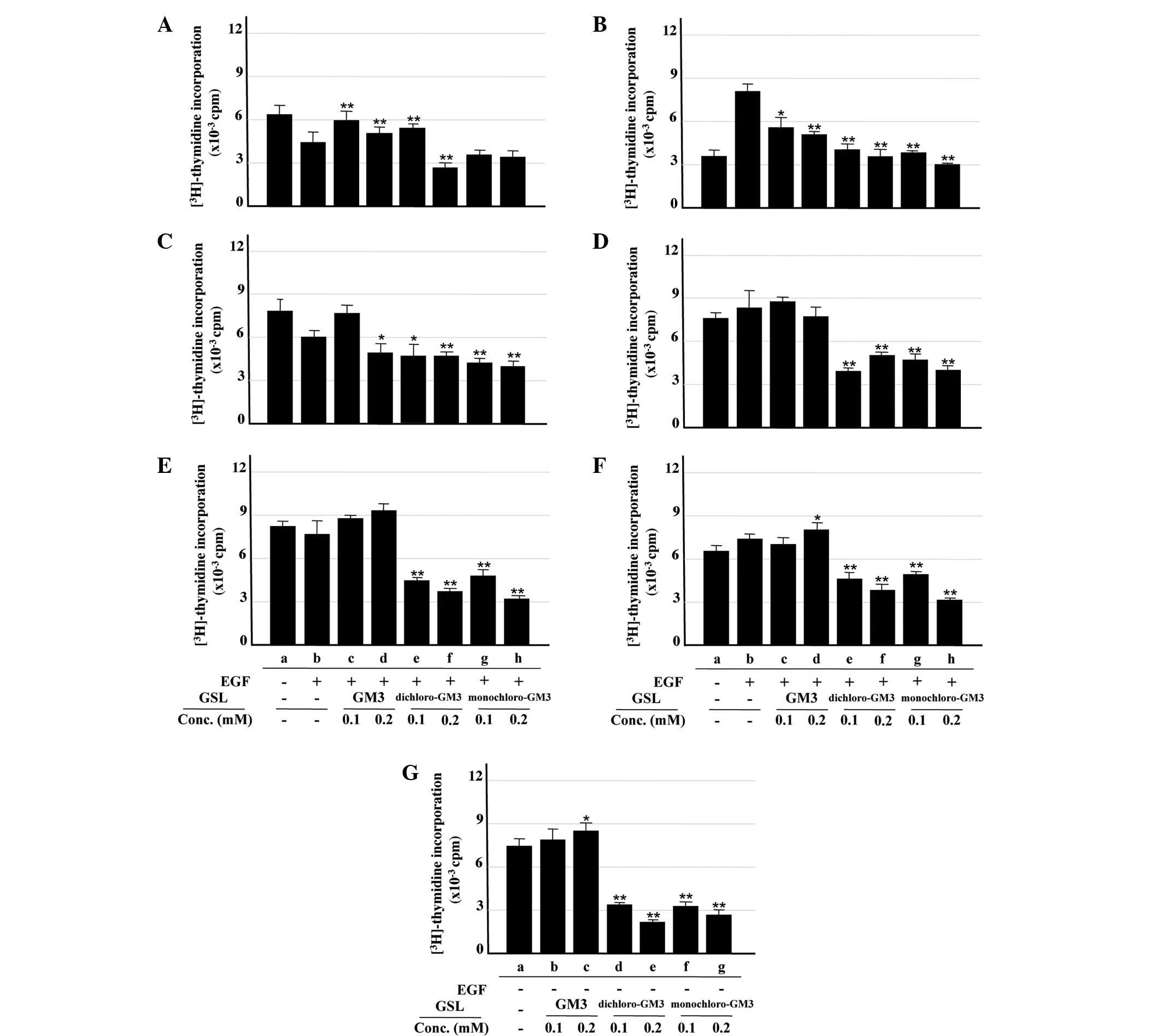|
1
|
Hakomori S: Tumor malignancy defined by
aberrant glycosylation and sphingo(glyco)lipid metabolism. Cancer
Res. 56:5309–5318. 1996.PubMed/NCBI
|
|
2
|
Bremer EG and Hakomori S: GM3 ganglioside
induces hamster fibroblast growth inhibition in chemically-defined
medium: ganglioside may regulate growth factor receptor function.
Biochem Biophys Res Commun. 106:711–718. 1982. View Article : Google Scholar
|
|
3
|
Bremer EG, Hakomori S, Bowen-Pope DF,
Raines E and Ross R: Ganglioside-mediated modulation of cell
growth, growth factor binding, and receptor phosphorylation. J Biol
Chem. 259:6818–6825. 1984.PubMed/NCBI
|
|
4
|
Bremer EG, Schlessinger J and Hakomori S:
Ganglioside-mediated modulation of cell growth. Specific effects of
GM3 on tyrosine phosphorylation of the epidermal growth factor
receptor. J Biol Chem. 261:2434–2440. 1986.
|
|
5
|
Miljan EA, Meuillet EJ, Mania-Farnell B,
et al: Interaction of the extracellular domain of the epidermal
growth factor receptor with gangliosides. J Biol Chem.
277:10108–10113. 2002. View Article : Google Scholar : PubMed/NCBI
|
|
6
|
Noll EN, Lin J, Nakatsuji Y, Miller RH and
Black PM: GM3 as a novel growth regulator for human gliomas. Exp
Neurol. 168:300–309. 2001. View Article : Google Scholar : PubMed/NCBI
|
|
7
|
Nakatsuji Y and Miller RH: Selective
cell-cycle arrest and induction of apoptosis in proliferating
neural cells by ganglioside GM3. Exp Neurol. 168:290–299. 2001.
View Article : Google Scholar : PubMed/NCBI
|
|
8
|
Hakomori S, Young WW Jr, Patt LM, Yoshino
T, Halfpap L and Lingwood CA: Cell biological and immunological
significance of ganglioside changes associated with transformation.
Adv Exp Med Biol. 125:247–261. 1980. View Article : Google Scholar : PubMed/NCBI
|
|
9
|
Nishikawa R, Ji XD, Harmon RC, et al: A
mutant epidermal growth factor receptor common in human glioma
confers enhanced tumorigenicity. Proc Natl Acad Sci USA.
91:7727–7731. 1994. View Article : Google Scholar : PubMed/NCBI
|
|
10
|
Furnari FB, Fenton T, Bachoo RM, et al:
Malignant astrocytic glioma: genetics, biology, and paths to
treatment. Genes Dev. 21:2683–2710. 2007. View Article : Google Scholar : PubMed/NCBI
|
|
11
|
Zhu ZY and Zhang YM: An efficient method
for ganglioside GM3 preparation. Acta Chim Sinica. 65:2909–2916.
2007.(In Chinese).
|
|
12
|
Tanaka H, Adachi M and Takahashi T:
One-pot synthesis of sialo-containing glycosyl amino acids by use
of an N-trichloroethoxycarbonyl-beta-thiophenyl sialoside.
Chemistry. 11:849–862. 2005. View Article : Google Scholar
|
|
13
|
Lin CC, Adak AK, Horng JC and Lin CC:
Phosphite-based sialic acid donors in the synthesis of α(2→9)
oligosialic acids. Tetrahedron. 65:4714–4725. 2009.
|
|
14
|
Byramova NE, Tuzikov AB and Bovin NV:
Studies on the synthesis of sialosides and sialic acid analogs. 2.
A simple procedure for the synthesis of the methyl and benzyl
glycosides of Neu5Ac and 4-epi-Neu5Ac - Conversion of the benzyl
and methyl glycosides of Neu5Ac into N-trifluoroacetylneuraminic
acid benzyl glycosides. Carbohydr Res. 237:161–175. 1992.
|
|
15
|
Fernandes H, Cohen S and Bishayee S:
Glycosylation-induced conformational modification positively
regulates receptor-receptor association: a study with an aberrant
epidermal growth factor receptor (EGFRvIII/DeltaEGRF) expressed in
cancer cells. J Biol Chem. 276:5375–5383. 2001. View Article : Google Scholar
|
|
16
|
Huang HS, Nagane M, Klingbeil CK, et al:
The enhanced tumorigenic activity of a mutant epidermal growth
factor receptor common in human cancers is mediated by threshold
levels of constitutive tyrosine phosphorylation and unattenuated
signaling. J Biol Chem. 272:2927–2935. 1997. View Article : Google Scholar
|
|
17
|
Zhou Q, Hakomori S, Kitamura K and
Igarashi Y: GM3 directly inhibits tyrosine phosphorylation and
de-N-acetyl-GM3 directly enhances serine phosphorylation of
epidermal growth factor receptor, independently of
receptor-receptor interaction. J Biol Chem. 269:1959–1965.
1994.
|
|
18
|
Yoon SJ, Nakayama K, Hikita T, Handa K and
Hakomori SI: Epidermal growth factor receptor tyrosine kinase is
modulated by GM3 interaction with N-linked GlcNAc termini of the
receptor. Proc Natl Acad Sci USA. 103:18987–18991. 2006. View Article : Google Scholar : PubMed/NCBI
|
|
19
|
Kawashima N, Yoon SJ, Itoh K and Nakayama
K: Tyrosine kinase activity of epidermal growth factor receptor is
regulated by GM3 binding through carbohydrate to carbohydrate
interactions. J Biol Chem. 284:6147–6155. 2009. View Article : Google Scholar
|
|
20
|
Todeschini AR, Dos Santos JN, Handa K and
Hakomori S: Ganglioside GM2-tetraspanin CD82 complex inhibits met
and its cross-talk with integrins, providing a basis for control of
cell motility through glycosynapse. J Biol Chem. 282:8123–8133.
2007. View Article : Google Scholar
|
|
21
|
Mitsuzuka K, Handa K, Satoh M, Arai Y and
Hakomori S: A specific microdomain (“glycosynapse 3”) controls
phenotypic conversion and reversion of bladder cancer cells through
GM3-mediated interaction of alpha3beta1 integrin with CD9. J Biol
Chem. 280:35545–34553. 2005.
|
|
22
|
Gabelman BM and Emerman JT: Effects of
estrogen, epidermal growth factor, and transforming growth
factor-alpha on the growth of human breast epithelial cells in
primary culture. Exp Cell Res. 201:113–118. 1992. View Article : Google Scholar : PubMed/NCBI
|
|
23
|
Zheng M and Ye XS: Synthesis of N-modified
ganglioside GM3 derivatives. Tetrahedron. 68:1475–1482. 2012.
View Article : Google Scholar
|
|
24
|
Hanai N, Nores GA, MacLeod C,
Torres-Mendez CR and Hakomori S: Ganglioside-mediated modulation of
cell growth. Specific effects of GM3 and lyso-GM3 in tyrosine
phosphorylation of the epidermal growth factor receptor. J Biol
Chem. 263:10915–10921. 1988.PubMed/NCBI
|
|
25
|
Ekstrand AJ, Sugawa N, James CD and
Collins VP: Amplified and rearranged epidermal growth factor
receptor genes in human glioblastomas reveal deletions of sequences
encoding portions of the N- and/or C-terminal tails. Proc Natl Acad
Sci USA. 89:4309–4313. 1992. View Article : Google Scholar
|
|
26
|
Sugawa N, Ekstrand AJ, James CD and
Collins VP: Identical splicing of aberrant epidermal growth factor
receptor transcripts from amplified rearranged genes in human
glioblastomas. Proc Natl Acad Sci USA. 87:8602–8606. 1990.
View Article : Google Scholar
|

















